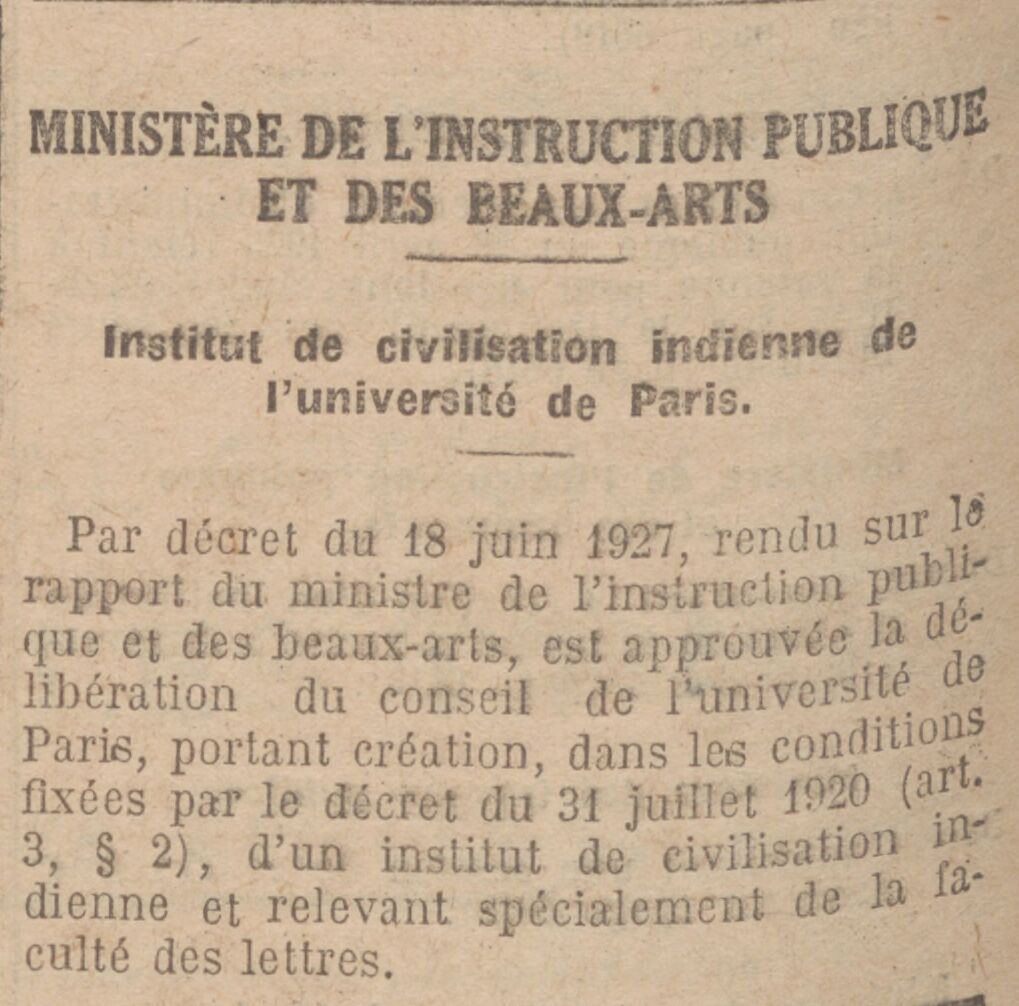Under the auspices of the University of Paris, the Institute's goal was to "coordinate, organise and develop studies relating to Indian civilisation", according to Article 2 of the Annex to the Decree. Its creation was the result of a dual movement. Firstly, the evolution of university courses in France, in particular with introduction of degrees that had no practical application in the late 19th century, with the opening of new programmes and creation of single-discipline academic institutions such as the Institut de Géographie (Institute of Geography) in 1910 and the Institut des Hautes Études Chinoises (Institute of Higher Chinese Studies) in 1921. Secondly, the ICI was very much part of the development of Indian studies in French higher education that had been underway for over a century. Émile Senart was appointed Director of the ICI upon its creation, but died a few months after taking up the post. Alfred Foucher, who was holder of the Chair in Sanskrit at the Sorbonne at the time, took over the post, and Sylvain Lévi was appointed Vice-President.
Journal officiel de la République française. Lois et décrets. 1927.
The Institute really came into its own in 1928. Its first activity report reminded members that its main role was "to centralise and coordinate courses relating to India taught at Paris' higher education institutions". Although the ICI had premises at the Sorbonne where the Paris Faculty of Arts' courses were taught, other classes were held at the Collège de France, the École Pratique des Hautes Études (EPHE – Practical School of Advanced Studies), the École des Langues Orientales Vivantes (ELOV – School of Living oriental Languages) and the École du Louvre (Louvre School). When it first opened, all humans sciences' disciplines were on the table: Vedic and Classical Sanskrit were taught by Louis Renou and Alfred Foucher, Middle-Indian and modern languages were Jules Bloch's preserve and art and archaeology were Alfred Foucher's field, while Sylvain Lévi and Jean Przyluski focused on Buddhism, Sylvain Lévi on Indian history, Alfred Foucher and Paul Masson-Oursel on philosophical movements and Louis Massignon on Muslim India. India was also considered in terms of its relations with its close geographical neighbours, and in the early years course programmes included classes on Khmer art (Philippe Stern), Indonesia (Gabriel Ferrand) and Malaysia (Antoine Cabaton), along with courses on Ancient Iran, the Avesta in particular, and Persian, taught by Émile Benveniste, and on Central Asia via the Kuchean texts studied by Sylvain Lévi. Classes in Tibetan were taught by Jacques Bacot. At the time, attending these classes led to obtainment of a Certificate of Indian Studies and then to a Graduate Degree in Indian Studies, after which students could prepare a university doctorate.
Alongside the official programme, French and foreign specialists were invited to deliver lectures. The ICI had the honour of receiving a good many prestigious guests, including the Bengali poet Rabindranath Tagore in 1930, So meeting another objective expressed in the 1929-1930 activity report: "Giving fresh impetus to scientific and cultural relations between France and India". In this context, the ICI also oversaw the arrival of Indian students intent on continuing their studies in Paris.
With a view to providing a wider public with tools of knowledge, a library was created at the ICI in 1929, initially provisioned by the donation of Émile Senart's library and then that of the Pandit Shyâmaji Krishnavarma (1857-1930). Acquisitions were made thanks to funding by French administrations (Ministry of Education, Ministry of the Colonies and the Governments of Indochina and French India) and Indian sponsors (Wadia Trust in Bombay, the Nizam of Hyderabad and the Gaekwad of Baroda). It also contained volumes published in India along with Indian and Indochinese periodicals and newspapers, almost nowhere to be found elsewhere in France. In 1938, the ICI's library contained some 15,000 volumes, making it the biggest Indology library in continental Europe, along with that of the German Oriental Society (Deutsche Morgenländische Gesellschaft) in Halle. Sanskrit and Pali texts, Jainism and Buddhism were particularly well represented.
Determination to disseminate knowledge also went alongside a policy of support to publications. As a result a series of bilingual works was developed (Sanskrit text and French translation), "Indian Classics" or the "Collection Émile Senart" under the impetus of Émile Senart's family and the Société Guillaume Budé. In 1932, the ICI also published a Sanskrit-French Dictionary edited by Nadine Stchoupak, Luigia Nitti and Louis Renou, which is still used by beginner students of Sanskrit.
In 1973, the ICI was attached to the Collège de France and in 2001 it was renamed Institut d'Études Indiennes (IEI – Institute of Indian Studies). Since 2023, it has been the Centre d'Études Indiennes et Centrasiatiques (Indian and Central Asian Studies Centre) at the Collège de France's Institut des Civilisations.
Written in february 2023
.png)

